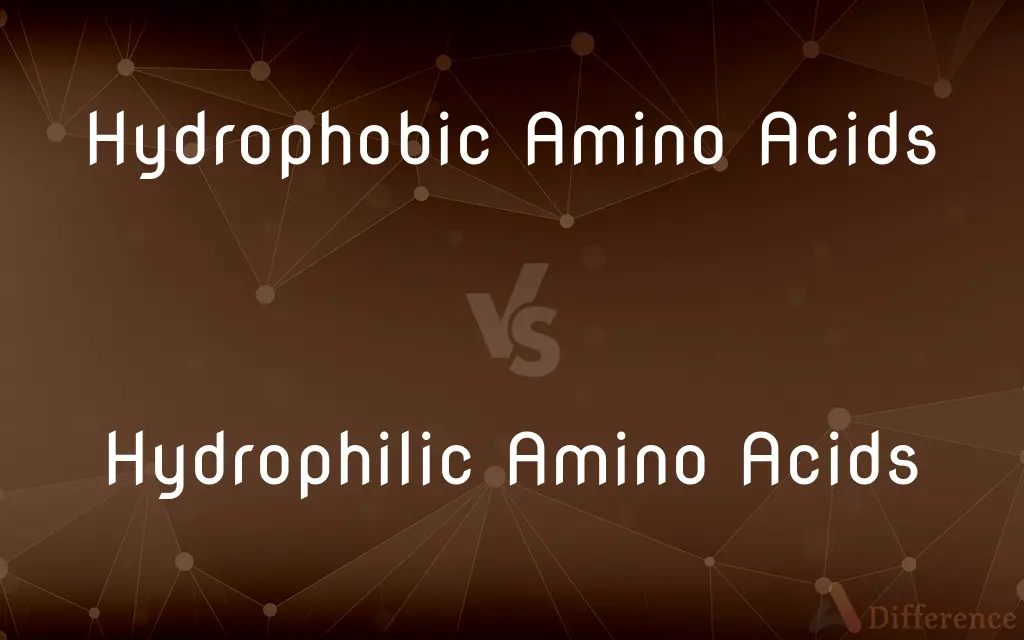Hydrophobic Amino Acids vs. Hydrophilic Amino Acids — What's the Difference?
By Tayyaba Rehman — Published on January 14, 2024
Hydrophobic amino acids avoid water and are nonpolar; hydrophilic amino acids interact favorably with water and are often polar or charged.

Difference Between Hydrophobic Amino Acids and Hydrophilic Amino Acids
Table of Contents
ADVERTISEMENT
Key Differences
Hydrophobic amino acids have nonpolar side chains that tend to repel the aqueous environment, leading to protein folding as they avoid water. Hydrophilic amino acids have polar or charged side chains that can form hydrogen bonds with water, making them soluble. Hydrophobic amino acids often reside in the interior of protein structures, while hydrophilic amino acids are found on the exterior, interacting with the aqueous cellular environment.
Hydrophobic amino acids play a critical role in the stability of protein structures by driving the folding process, due to their aversion to water. Hydrophilic amino acids contribute to the protein's function, such as enzyme catalysis, by interacting with substrates and other proteins. While hydrophobic amino acids provide structural integrity to proteins, hydrophilic amino acids ensure proteins can interact with the complex cellular environment.
The nature of hydrophobic amino acids leads to less dynamic protein regions due to the rigid nature of the nonpolar side chains. Hydrophilic amino acids allow for more flexibility and dynamic regions within proteins because of their ability to form multiple hydrogen bonds with water. This contrast between hydrophobic and hydrophilic amino acids reflects the diversity of protein functions and structures.
Hydrophobic amino acids are typically found in membrane proteins, where they interact with lipid bilayers, while hydrophilic amino acids are often in aqueous solutions interacting with water molecules. Understanding the placement and role of these amino acids is crucial in predicting protein structure and function. Hydrophobic and hydrophilic amino acids' properties are essential for the precise assembly of complex protein structures and their biological functions.
Comparison Chart
Solubility in Water
Insoluble or less soluble
Soluble or more soluble
ADVERTISEMENT
Side Chain Characteristics
Nonpolar
Polar or charged
Role in Protein Structure
Stabilize protein core, promote folding
Facilitate interaction with the environment
Interaction with Water
Avoid interaction with water
Interact favorably with water
Common Locations in Proteins
Inside protein structure
Protein surface, exposed to aqueous solution
Compare with Definitions
Hydrophobic Amino Acids
Hydrophobic amino acids: Critical for membrane protein's amino acids.
Methionine is hydrophobic, often found within the membrane-spanning regions of proteins.
Hydrophilic Amino Acids
Hydrophilic amino acids: Essential for protein interaction amino acids.
Lysine is hydrophilic, frequently involved in binding with other molecules.
Hydrophobic Amino Acids
Hydrophobic amino acids: Water-repellent amino acids.
Leucine's hydrophobic nature makes it critical in protein folding.
Hydrophilic Amino Acids
Hydrophilic amino acids: Amino acids with polar or charged side chains.
Arginine is hydrophilic, making it prevalent in active sites.
Hydrophobic Amino Acids
Hydrophobic amino acids: Insoluble in water amino acids.
Phenylalanine is hydrophobic and contributes to protein stability.
Hydrophilic Amino Acids
Hydrophilic amino acids: Surface-located amino acids in proteins.
Serine's hydrophilic nature ensures it's typically found on the protein surface.
Hydrophobic Amino Acids
Hydrophobic amino acids: Amino acids with nonpolar side chains.
Valine, a hydrophobic amino acid, is often found in the interior of proteins.
Hydrophilic Amino Acids
Hydrophilic amino acids: Water-attracting amino acids.
Glutamine remains hydrophilic, stabilizing protein interaction with water.
Hydrophobic Amino Acids
Hydrophobic amino acids: Core structure-forming amino acids.
Tryptophan, a hydrophobic amino acid, is commonly located away from water.
Hydrophilic Amino Acids
Hydrophilic amino acids: Soluble in water amino acids.
Aspartic acid is hydrophilic and often participates in enzyme catalysis.
Common Curiosities
What is a characteristic of a hydrophilic amino acid?
Hydrophilic amino acids have polar or charged side chains that attract water.
What defines a hydrophobic amino acid?
It's defined by its nonpolar side chain and tendency to repel water.
How do hydrophilic amino acids affect protein function?
They facilitate protein interactions with other molecules and the surrounding environment.
Why are hydrophobic amino acids important in proteins?
They help stabilize protein structures by promoting proper folding.
Can a protein have both hydrophobic and hydrophilic amino acids?
Yes, proteins typically contain a mix, contributing to their complex structure and function.
Are hydrophilic amino acids essential for protein-protein interactions?
Yes, their ability to form hydrogen bonds and ionic interactions facilitates these interactions.
Where are hydrophobic amino acids usually located in a protein?
They're often found in the interior of the protein structure, away from water.
Are all hydrophilic amino acids charged?
Not all; some are simply polar, but others are indeed charged at physiological pH.
How are hydrophilic amino acids involved in cell signaling?
They often participate in interactions with signaling molecules due to their surface location.
How does the amino acid sequence affect protein solubility?
The sequence and proportion of hydrophobic vs. hydrophilic amino acids determine solubility.
What's an example of a hydrophobic amino acid?
Isoleucine is an example of a hydrophobic amino acid.
Can hydrophilic amino acids be found in the interior of proteins?
Rarely, but when they are, they typically play a crucial role in the protein's function.
Do hydrophobic amino acids participate in hydrogen bonding?
No, they typically do not form hydrogen bonds due to their nonpolar nature.
Is the classification of amino acids as hydrophobic or hydrophilic absolute?
No, it can be context-dependent, based on protein structure and environmental conditions.
What's the role of hydrophobic amino acids in membrane proteins?
They interact with the lipid bilayer, anchoring the protein in the membrane.
Share Your Discovery

Previous Comparison
Isopropyl vs. Ethyl Alcohol
Next Comparison
Android 9.0 vs. Android 10Author Spotlight
Written by
Tayyaba RehmanTayyaba Rehman is a distinguished writer, currently serving as a primary contributor to askdifference.com. As a researcher in semantics and etymology, Tayyaba's passion for the complexity of languages and their distinctions has found a perfect home on the platform. Tayyaba delves into the intricacies of language, distinguishing between commonly confused words and phrases, thereby providing clarity for readers worldwide.












































